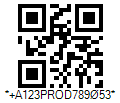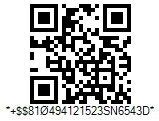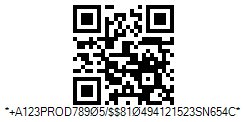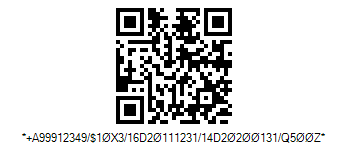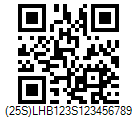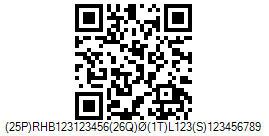HIBC LIC QR Code Barcode
This Symbology is also known as HIBCC LIC, HIBC Labeler Identification Code, HIBC Supplier Labeling Standard Barcode, HIBC SLS Barcode, HIBC LIC Primary Data Structure, HIBC LIC Secondary Data Structure, HIBC QR Code, HIBC PCN Barcode, HIBC Universal Product Number, HIBC UPN Barcode, Health Industry Bar Code, Health Industry Business Communications Council Barcode.
This Barcode Symbology is supported by the following Neodynamic products:
Overview
 The HIBC LIC is used by Labelers (manufacturers) of health care products for identification purpose. Labelers can encode which is called "Primary Data" and "Secondary Data". In short, Primary Data identifies the labeler, the product code, and the unit of measure while Secondary Data is useful to distributors and providers and, at the discretion of the labeler, should be added. The Secondary Data is optional and is used in conjunction with Primary Data elements to encode quantity and/or expiration (expiry) date and/or Lot Number.
The HIBC LIC is used by Labelers (manufacturers) of health care products for identification purpose. Labelers can encode which is called "Primary Data" and "Secondary Data". In short, Primary Data identifies the labeler, the product code, and the unit of measure while Secondary Data is useful to distributors and providers and, at the discretion of the labeler, should be added. The Secondary Data is optional and is used in conjunction with Primary Data elements to encode quantity and/or expiration (expiry) date and/or Lot Number.
The HIBC LIC Primary and Secondary Data Structures are represented by a QR Code 2D barcode.
HIBC LIC Primary Data Structure
The HIBC LIC Primary Data Structure format encodes:
- "+" sign identifier of the HIBC Supplier Data Structure
- 4 character Labeler Identification Code (LIC)
- 1 to 13 character Product or Catalog Number (PCN)
- 1-digit Unit of Measure Identifier (U/M)
- a Checksum which is automatically calculated by Barcode Professional.
HIBC LIC Secondary Data Structure
The HIBC LIC secondary Data Structure format encodes:
- "+" sign identifier of the HIBC Supplier Data Structure
- Variable-length characters for Quantity/Date Fields
- 0 to 13 characters for Lot Number Field
- 1 character for Link Character (which is the Checksum from Primary Data Structure)
- a Checksum which is automatically calculated by Barcode Professional.
Combining Primary and Secondary Codes in One Symbol
Labelers can encode in one only symbol both the Primary and Secondary Data by using the HIBC LIC Concatenation Format. In this case, a slash (/) is used as a delimiter between the Primary and Secondary Data. In addition, the Primary Data Link Character, the plus (+) at the start of the Secondary Data, and the Secondary Data Link Character are omitted. Only one Checksum at the end of the symbol is used which will verify the entire symbol.
Additional Supplemental Data
Additional Supplemental Data can be added to the Secondary data string. Additional Supplemental Data can be used when a manufacturer wishes to encode both lot number and serial number in the same symbol, date of manufacture, expiry date in the YYYYMMDD format, and/or quantity. Quantity must be the last field in supplemental data when used in conjunction with other supplemental data.
ISO/IEC 15434 Message Format
Labelers may wish to use the message format defined in ISO/IEC 15434 with Data Identifiers (DIs) for creating 2D HIBCC LIC barcodes. This may apply to small packages where the label is small, and insufficient for the inclusion of a linear 1D barcode. It may also apply to labelers who wish to include other data in the symbol otherwise not available by using this standard. For example, a manufacturer may wish to include separately the production date and the expiry date for a product.
How to create HIBC LIC QR Code barcodes using Barcode Professional for
Note: Please refer to the Class Reference documentation for more information about the properties and methods stated in this document.
In order to get a HIBC LIC QR Code barcode image, please follow these steps:
NOTE: This HIBC LIC is rendered as a
QR Code 2D barcode so all settings (like module size) for QR Code will be taken into account when generating a HIBC LIC symbol.
- Set the Symbology property to HibcLicQRCode
- Setting up dimensions and quiet zones:
- Set the QRCodeModuleSize property (Values are expressed in Inches)
- Set the QuietZoneWidth property (Value is expressed in Inches)
- Set the TopMargin and BottomMargin properties (Values are expressed in Inches)
- Set the Code property with the value to encode. Learn the different data encodings by referring to:
- Set the HibcFormatHumanReadableText property. If true (default value), then Human Readable Text is formatted as specified by HIBC Standards i.e. Zeros are displayed as Slashed-Zeros and the Space character is displayed as an Underscore.
- Set the HibcUseIsoIec15434Encoding property. Default value is False. If it's set to True, then the Code property will be processed and encoded by following ISO/IEC 15434 standard.
Note: Please refer to the Class Reference documentation for more information about the properties and methods stated in this document.
In order to get a HIBC LIC QR Code barcode image, please follow these steps:
NOTE: This HIBC LIC is rendered as a
QR Code 2D barcode so all settings (like module size) for QR Code will be taken into account when generating a HIBC LIC symbol.
- Set the Symbology property to HibcLicQRCode
- Setting up dimensions and quiet zones:
All values for barcode dimensions are expressed in INCHES by default. However, Barcode Professional supports other unit of measurement such as Millimeter, Centimeter, and Mils. For modifying the unit of measurement for barcoding, please set up the BarcodeUnit property as needed.
- Set the QRCodeModuleSize property (Values are expressed in Inches)
- Set the QuietZone property (Value is expressed in Inches)
- Set the Code property with the value to encode. Learn the different data encodings by referring to:
- Set the HibcFormatHumanReadableText property. If true (default value), then Human Readable Text is formatted as specified by HIBC Standards i.e. Zeros are displayed as Slashed-Zeros and the Space character is displayed as an Underscore.
- Set the HibcUseIsoIec15434Encoding property. Default value is False. If it's set to True, then the Code property will be processed and encoded by following ISO/IEC 15434 standard.
How to encode Primary Data
You can encode Primary Data Structure by just passing to Barcode Professional the
Universal Product Number (
UPN).
UPN is composed of
LIC +
PCN +
UM.
- LIC is the Labeler Identification Code which is assigned by HIBCC. It identifies the labeler and begins with a letter, followed by 3 alphanumeric characters.
- PCN is the Product/Catalogue Number which is assigned by the labeler. It identifies the item/drug/device and is made of 1 to 13 alphanumeric characters.
- UM is the Unit of Measure which is assigned by the labeler. It is 1-digit and identifies the packaging configuration level of the item; e.g. Unit-Dose, Carton, Case, Master-Case, Pallet, etc.
Example of encoding Primary Data
How to encode Secondary Data
Barcode Professional provides an easy data format for encoding Secondary Data Structure. The Secondary Data fields Quantity, Date, and Lot Number are separated by # (Cross hatch or number sign) and you can optionally instruct to Barcode Professional for computing the "Link Character" by placing the "Primary Data" between parentheses at the end of the value to encode as is shown below.
QUANTITY#DATE#LOT_NUM(PRIMARY_DATA)
Where:
- QUANTITY is the quantity field. You must specify one of the following valid values for this field:
- 0 (zero) if Quantity Field is NOT required
- 2-digit for Quantity
- 5-digit for Quantity
- DATE is the expiration date field. You must specify one of the following valid values for this field:
- 0 (zero) if Date Field is NOT required
- 4-digit if using MMYY (month/year) Date format
- Number 2 (two) followed by 6-digit if using MMDDYY (month/day/year) Date format
- Number 3 (three) followed by 6-digit if using YYMMDD (year/month/day) Date format
- Number 4 (four) followed by 8-digit if using YYMMDDHH (year/month/day/hour G.M.T.) Date format
- Number 5 (five) followed by 5-digit if using YYJJJ (year/Julian day) Date format
- Number 6 (six) followed by 7-digit if using YYJJJHH (year/Julian day/hour G.M.T.) Date format
- Number 7 (seven) for Date Field is NULL
- LOT_NUM is the Lot Number field. You must specify one of the following valid values for this field:
- - (Hyphen, dash, or minus sign) for Lot Number Field is NOT required
- 1 to 13 alphanumeric characters (A-Z and 0-9)
- (PRIMARY_DATA) is the Primary Data content which must be placed between parentheses if you want the "Link Character" to be computed by Barcode Professional. NOTE: This element is optional.
Example of encoding Secondary Data
How to encode Primary and Secondary Data in One Symbol
For encoding Primary and Secondary Data in one symbol, the following format must be used:
UPN/QUANTITY#DATE#LOT_NUM
The / (slash) character is used as separator between both data structures and UPN, QUANTITY, DATE, and LOT_NUM have the aforementioned meanings.
Example of encoding Primary and Secondary Data in One Symbol
How to encode Secondary Data with Additional Supplemental Data
It is strongly recommended that Additional Supplemental Data be used in the concatenated format and with 2D symbologies (like
Aztec Code,
Data Matrix, or
QR Code) to reduce the risk of creating a linear bar code that may be too long for practical use.
Additional Supplemental Data can be added to the Secondary data string. The Secondary Supplemental Data field is constructed with a "/" character followed by a Data Identifier (DI), followed by data. Multiple Secondary Supplemental data fields are possible. The Secondary Supplemental Data will always follow the Secondary data, and the check character will be inserted at the end of the total string. The following are the Supplemental Data Fields:
| Data Field Name |
Data Identifier |
Data Content Type |
| Serial Number |
/S |
Alphanumeric [A-Z][0-9] (from 1 up to 18 chars) |
| Date of Manufacture |
/16D |
YYYYMMDD |
| Expiry date formatted as YYYYMMDD |
/14D |
YYYYMMDD |
| Quantity |
/Q |
Numeric [0-9] (from 1 up to 5 digits) |
Example of encoding Primary and Secondary Data with Additional Supplemental Data
Example of HIBC LIC QR Code barcodes
NOTE: This HIBC LIC is rendered as a
QR Code 2D barcode so all settings (like module size) for QR Code will be taken into account when generating a HIBC LIC symbol.
- Primary Data Example: Encoding LIC = A123, PCN = PROD7890, and UM = 5. Based on that info, then UPN = A123PROD78905
Code property = A123PROD78905 will produce the following barcode image:
- Secondary Data Example: Encoding Quantity = 10, Date = 12/15/94 23:00 G.M.T. (YYMMDDHH Date Format so Number 4 will be the prefix), and Lot = SN654. Primary Data for Link Character calculation = A123PROD78905.
Code property = 10#494121523#SN654(A123PROD78905) will produce the following barcode image:
- Primary and Secondary Data in One Symbol Example: Encoding for Primary Data LIC = A123, PCN = PROD7890, and UM = 5 i.e. UPN = A123PROD78905. For Secondary Data Quantity = 10, Date = 12/15/94 23:00 G.M.T. (YYMMDDHH Date Format so Number 4 will be the prefix), and Lot = SN654.
Code property = A123PROD78905/10#494121523#SN654 will produce the following barcode image:
- Primary and Secondary Data with Additional Supplemental Data Example: Encoding for Primary Data LIC = A999, PCN = 1234, and UM = 9 i.e. UPN = A99912349. For Secondary Data Quantity = 0, Date = None, and Lot = 10X3. For Additional Supplemental Data Quantity = 500, Date of Manufacture = 20111231 (December 31, 2011) and Expiry = 20200131 (January 31, 2020)
Code property = A99912349/0#0#10X3/16D20111231/14D20200131/Q500 will produce the following barcode image:
Encoding Data Identifiers through ISO/IEC 15434 Standard
For encoding HIBC LIC 2D barcodes by following ISO/IEC 15434 standard, each element to be encoded must be specified as a Data Identifier surrounded by parentheses together the data that DI represents. The following are the most common DI used in HIBC barcodes:
- 25P (Supplier assigned Part Number)
- 25S (Supplier assigned Serial Number)
- S (Serial Number)
- 26Q (Packaging Level)
- 1T (LOT number)
- 16D (Production date formatted as YYYYMMDD)
- 14D (Expiry Date formatted as YYYYMMDD)
NOTE: This HIBC LIC is rendered as a
QR Code 2D barcode so all settings (like module size) for QR Code will be taken into account when generating a HIBC LIC symbol.
- Supplier Serial Number (single DI sample)
Code property = (25S)LHB123S123456789 & HibcUseIsoIec15434Encoding property = True will produce the following barcode image:
- Supplier Part Number + Lot Number + Serial Number: (multiple DIs sample)
Code property = (25P)RHB123123456(26Q)0(1T)L123(S)123456789 & HibcUseIsoIec15434Encoding property = True will produce the following barcode image:


 The HIBC LIC is used by Labelers (manufacturers) of health care products for identification purpose. Labelers can encode which is called "Primary Data" and "Secondary Data". In short, Primary Data identifies the labeler, the product code, and the unit of measure while Secondary Data is useful to distributors and providers and, at the discretion of the labeler, should be added. The Secondary Data is optional and is used in conjunction with Primary Data elements to encode quantity and/or expiration (expiry) date and/or Lot Number.
The HIBC LIC is used by Labelers (manufacturers) of health care products for identification purpose. Labelers can encode which is called "Primary Data" and "Secondary Data". In short, Primary Data identifies the labeler, the product code, and the unit of measure while Secondary Data is useful to distributors and providers and, at the discretion of the labeler, should be added. The Secondary Data is optional and is used in conjunction with Primary Data elements to encode quantity and/or expiration (expiry) date and/or Lot Number.
